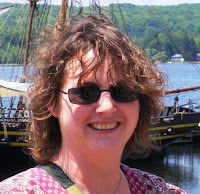Carol Law
Festival Nomad Correspondent
Scouts Canada Participats at Niagara-on-the Lake
featuring Article Submitted by Carol Law
Part 4 ...
We will conclued this series with Festival Nomad Correspondent, Carol Law’s article about her adventures during this past summers experience with Scouts Canada.
Mindful that there have been troubling times in peace time as well, a moment of silence was observed this year to remember the events of 9/11 ten years ago. I was there for the 1812 camp the weekend following 9/11. We didn't know if the Americans would come. Then we didn't know if they would be able to get through the border - with so many youth? With imitation muskets and cannons? A cheer went up in the field when we heard they were trying to come. Three "hassahs" (British military cheer) went up in the field when we heard they were coming.
We later learned that the leaders explained the bus loads (over 600 Scouts from the US
On the last day of camp, teen years ago, it was the British side's turn to lead into the Fort for the closing. Imagine a column of almost 2000 people marching across the field, four abreast; the line stretches for over a kilometer. Spontaneously, without discussion, or planned decision, the British troops silently stopped at the Fort gate and formed an honour guard for the American Scouts allowing them to enter the Fort first. 2000 youth were silent for over 20 minutes; this was not asked of them, they recognized the significance of the gesture and gave it out of respect. The closing remarks were very moving that morning. It made you think about what was important. And that, while we teach our youth about what happened 200 years ago, it is what we do with that knowledge today that makes it all worth while.
This is why the War of 1812 is significant; because we can celebrate peace, and work together for the important things.
That is why Scouts Canada Fort George Scout campaign will once again descend on Niagara on the Lake . It is anticipated that over 4000 Scouting members will be there to re-enact the war of 1812 and celebrate peace between our nations once again.




































